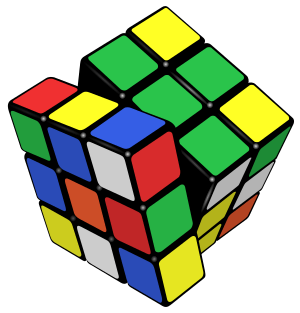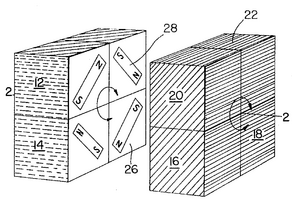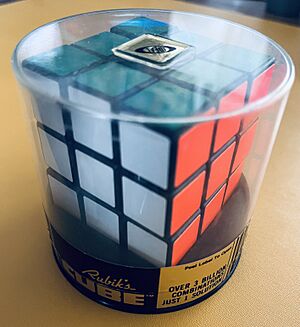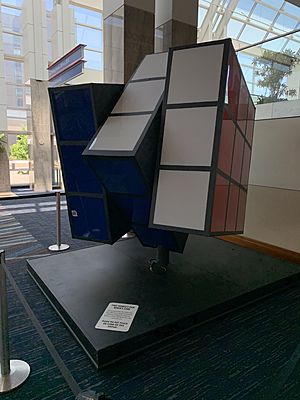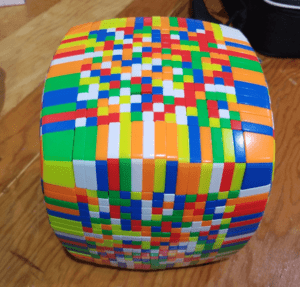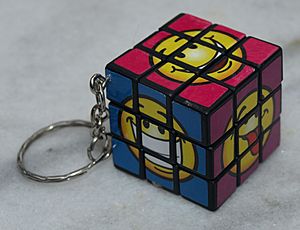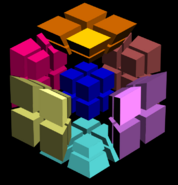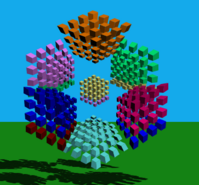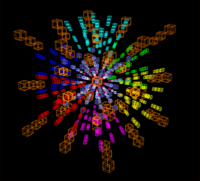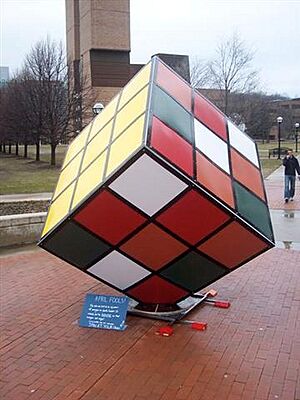Rubik's Cube facts for kids
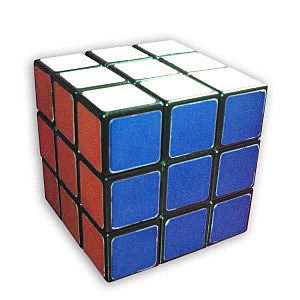 |
|
| Other names | Magic Cube, Speed Cube, Puzzle Cube, Cube |
|---|---|
| Type | Combination puzzle |
| Inventor(s) | Ernő Rubik |
| Company | Rubik's Brand Ltd (Spin Master) |
| Country | Hungary |
| Availability | 1977: as Hungarian Magic Cube, first test batches released in Budapest As Rubik's Cube, worldwide, 1980–present |
The Rubik's Cube is a super popular 3D combination puzzle. It was invented in 1974 by Hungarian sculptor and professor Ernő Rubik. At first, it was called the Magic Cube. Rubik allowed it to be sold in the UK in 1978. Then, in 1980, it was released all over the world. The Rubik's Cube quickly became one of the most famous toys ever!
In 1980, it even won a special award in Germany for Best Puzzle. By 2024, about 500 million cubes had been sold. This makes it the world's best-selling puzzle game and toy. The Rubik's Cube was added to the US National Toy Hall of Fame in 2014.
On the classic Rubik's Cube, each of its six sides had nine stickers. Each side was a solid color: white, red, blue, orange, green, or yellow. Newer cubes use colored plastic instead of stickers. This means the colors won't peel off or fade! Since 1988, the colors have been set in a standard way. White is always opposite yellow, blue is opposite green, and orange is opposite red. Also, red, white, and blue are arranged in a clockwise order. On older cubes, the colors were sometimes in different spots.
Inside the cube, a special turning system lets each side spin on its own. This mixes up the colors. To solve the puzzle, you must turn the sides until each face has only one color again. The Rubik's Cube has inspired many other puzzles with different shapes and sizes. Even though it was super popular in the 1980s, it's still well-known today. Many people called "speedcubers" still practice solving it super fast! They even compete to see who can solve it the quickest. Since 2003, the World Cube Association (WCA) has organized competitions and kept track of world records.
Contents
History of the Rubik's Cube
How the Rubik's Cube Started
Before Rubik's Cube, other people had similar ideas. In 1970, a man named Larry D. Nichols invented a 2x2x2 cube puzzle. His cube used magnets to hold the pieces together. He got a patent for it in 1972, two years before Rubik made his cube.
Rubik's Big Idea
In the mid-1970s, Ernő Rubik was a professor in Budapest, Hungary. He wanted to solve a problem: how could parts of a 3D object move independently without falling apart? He built a cube to figure this out. He didn't even realize he had made a puzzle until he mixed it up and tried to fix it!
Rubik applied for a patent in Hungary for his "Magic Cube" in 1975. The first test cubes were sold in toy shops in Budapest in late 1977. Unlike Nichols's cube, Rubik's Magic Cube used interlocking plastic pieces to stay together.
In 1979, a businessman named Tibor Laczi showed the Magic Cube at a toy fair in Germany. Tom Kremer, who founded Seven Towns, saw it and loved it. They made a deal with Ideal Toys to sell the Magic Cube worldwide. Ideal Toys wanted a name people would remember. So, in 1980, the "Magic Cube" was renamed "Rubik's Cube" after its inventor! It was first shown internationally at toy fairs in London, Paris, Nuremberg, and New York in early 1980.
Before hitting stores, the cube was made lighter and packaged for Western markets. The first Rubik's Cubes were sent from Hungary in May 1980. The packaging varied, but a clear plastic cylinder was common. Some early cubes also had slightly different color arrangements.
The Cube Craze of the 1980s
When the Rubik's Cube first came out in May 1980, sales were slow. But then Ideal Toys started advertising it on TV and in newspapers. By the end of 1980, the Rubik's Cube won awards in Germany, the UK, France, and the US. By 1981, it was a huge craze! Between 1980 and 1983, about 200 million Rubik's Cubes were sold worldwide.
Many people could only solve one or two sides of the cube. So, lots of books were published to help, like You Can Do The Cube by Patrick Bossert. In 1981, three of the top ten best-selling books in the US were about solving the Rubik's Cube! The best-selling book of 1981, The Simple Solution to Rubik's Cube, sold over 6 million copies.
The Rubik's Cube was even shown in the Museum of Modern Art in New York. At the 1982 World's Fair in Knoxville, Tennessee, a giant six-foot cube was on display. There was even a cartoon show called Rubik, the Amazing Cube! In June 1982, the first official Rubik's Cube World Championship was held in Budapest.
By late 1982, sales started to slow down in some countries. But in places like China and the USSR, the craze was just starting!
The Cube's Comeback in the 2000s
The Rubik's Cube continued to be sold through the 1980s and 1990s. But in the early 2000s, interest in the cube grew again. In the US, sales doubled between 2001 and 2003. People started thinking it was "cool to own a Cube again."
The 2003 World Rubik's Games Championship was the first big speedcubing event since 1982. It led to the creation of the World Cube Association in 2004. By 2008, 15 million Rubik's brand cubes were sold each year worldwide. Part of this new popularity came from websites like YouTube. People could share videos of how they solved the cube.
After Rubik's patent expired in 2000, other companies, especially Chinese ones, started making their own cubes. Many of these new cubes were designed to be super fast, which speedcubers loved. In 2020, Spin Master bought the Rubik's Cube brand for $50 million.
How the Rubik's Cube Works
A standard Rubik's Cube is about 5.6 centimeters (2.2 inches) on each side. It's made of 26 small pieces, often called "cubies." Each cubie has a hidden part that connects with the others. This allows them to move around without the whole puzzle falling apart.
The center piece of each of the six faces is just a single colored square. These six center pieces are attached to the core of the cube. They provide the structure for all the other pieces to fit into and spin around. So, there are 21 main parts: a core that holds the six center squares in place (but lets them rotate), and 20 smaller plastic pieces that fit around it.
Each center piece spins on a fastener held by the core. A spring inside pushes each piece inward, keeping the cube tight but easy to turn. Older official cubes had screws you could tighten or loosen to change how the cube felt. Newer ones have rivets, so they can't be adjusted. Cheaper copies might just use plastic clips.
You can actually take the cube apart pretty easily. Just turn the top layer 45 degrees and gently pull one of the edge pieces away. This means you could "solve" a cube by taking it apart and putting it back together in the solved state!
The cube has six center pieces (one color each), twelve edge pieces (two colors each), and eight corner pieces (three colors each). Each piece has a unique color combination. For example, you won't find an edge piece with both red and orange if those colors are on opposite sides of a solved cube. You can change where these pieces are by twisting an outer third of the cube 90 degrees at a time. However, the colors on the center squares always stay in the same position relative to each other. This means the overall color layout of the solved cube is fixed.
Solving the Rubik's Cube
Understanding Cube Moves (Singmaster Notation)
Many Rubik's Cube fans use a special language to write down how to move the cube. It's called "Singmaster notation" or "Cube notation." This way, you can write down a series of moves that will work no matter how you hold the cube or what colors are where.
Here are the basic moves:
- F (Front): Turn the side facing you.
- B (Back): Turn the side opposite the front.
- U (Up): Turn the top side.
- D (Down): Turn the bottom side.
- L (Left): Turn the side to the left of the front.
- R (Right): Turn the side to the right of the front.
If a letter has a little mark (like R′), it means turn that side counter-clockwise. If there's no mark (like R), turn it clockwise. These directions are as if you are looking directly at that side. If a letter has a '2' (like R2), it means turn that side twice, or 180 degrees.
You can also turn the whole cube:
- x: Rotate the whole cube like an R turn.
- y: Rotate the whole cube like a U turn.
- z: Rotate the whole cube like an F turn.
Sometimes, you'll see lowercase letters (like r) or a 'w' (like Rw). These mean to turn two layers at once (the outer layer and the middle layer next to it). For bigger cubes (like 4x4x4 or more), numbers are used to show how many layers to turn.
Fast Ways to Solve (Speedcubing Methods)
Speedcubers use special methods to solve the cube super fast. One very popular method is called CFOP. This stands for "Cross, F2L, OLL, PLL."
- Cross: First, you solve a cross shape on one side of the cube.
- F2L (First Two Layers): Then, you solve the first two layers at the same time. You pair up corner pieces with edge pieces.
- OLL (Orient Last Layer): Next, you get all the pieces on the top layer facing the right way.
- PLL (Permute Last Layer): Finally, you move the pieces on the top layer into their correct spots.
This method uses many memorized move sequences, called "algorithms." Most advanced speedcubers know all 120 algorithms for OLL and PLL!
Other methods exist too, like the Petrus method and the Roux method. These often involve building blocks of solved pieces instead of layer by layer.
Easy Ways for Beginners
Most beginners learn to solve the cube "layer by layer." This means you solve one layer first, then the middle layer, and finally the last layer. These methods use just a few simple algorithms.
In 1981, a 13-year-old named Patrick Bossert wrote a book called You Can Do The Cube. It showed an easy way to solve the cube with simple pictures. This book became a best-seller!
There are also online programs that can solve a Rubik's Cube for you. You just tell the program what colors are on each side of your scrambled cube, and it will give you the steps to solve it!
Competitions and Records
Speedcubing Competitions
Speedcubing is all about solving the Rubik's Cube as fast as possible. There are many competitions held around the world!
The first world championship was in Budapest in 1982. It was won by Minh Thai, who solved the cube in 22.95 seconds! Since 2003, the World Cube Association (WCA) organizes these events. They keep track of all the world records. In competitions, they use special timers. The winner is usually decided by the average time of their middle three solves out of five attempts.
Besides the regular 3x3x3 event, there are other cool ways to solve the cube in competitions:
- Blindfolded solving: You look at the cube, memorize it, then put on a blindfold and solve it!
- Multiple blindfolded solving: You memorize many cubes, then solve them all blindfolded in a row.
- One-handed solving: You solve the cube using only one hand.
- Fewest moves solving: You get an hour to figure out the shortest possible way to solve a scrambled cube and write down your solution.
Amazing Records
Here are some of the fastest times and most impressive records for solving the Rubik's Cube:
- Fastest Single Solve: The world record is an incredible 3.13 seconds! This was set by Max Park from the United States in June 2023.
- Fastest Average Solve: The world record for the average of five solves is 4.48 seconds. This was set by Yiheng Wang from China in June 2023.
- One-Handed Solve: Max Park also holds the record for the fastest one-handed solve at 6.20 seconds (August 2022).
- Blindfolded Solve: The fastest blindfolded solve is 12.00 seconds, set by Tommy Cherry from the United States in February 2024. This time includes memorizing the cube!
- Multiple Blindfolded Solves: Graham Siggins from the United States solved 62 out of 65 cubes blindfolded in under an hour in June 2022!
- Fewest Moves Solve: The record for solving a cube in the fewest moves is 16 moves. Sebastiano Tronto from Italy achieved this in June 2019.
Top 10 Fastest Solvers (Single Solve)
Different Kinds of Rubik's Cubes
Error: Found poly with odd number of coordinates on line 9
There are many different kinds of Rubik's Cubes! The most common ones change the "order" of the cube. This means how many layers it has on each side. The 2x2x2 (Pocket Cube), the standard 3x3x3, the 4x4x4 (Rubik's Revenge), and the 5x5x5 (Professor's Cube) are the most famous. The WCA even has competitions for cubes up to 7x7x7!
Even bigger cubes exist, like the 17x17x17 "Over the Top" cube. It was once the largest and most expensive cube sold! Now, Chinese companies make many large cubes, including a 21x21x21 cube.
Besides cubes, there are many other "twisty puzzles" inspired by the Rubik's Cube. These come in different geometric shapes. Some examples are the Pyraminx (a triangle shape), the Megaminx (a 12-sided shape), and the Square One (which changes shape!).
Custom-Made Puzzles
People also build their own puzzles based on the Rubik's Cube. For example, a "cuboid" is like a Rubik's Cube but has different sizes, like 2x2x4 or 3x3x5. Other modifications change the shape of the cube, like making it into an octahedron.
Rubik's Cube on Computers
You can also find Rubik's Cube puzzles on computers! Software can create huge puzzles that would be too big to build in real life. They can even make virtual puzzles that can't exist physically.
Google even made something called "Chrome Cube Lab." It has interactive Rubik's Cube objects online. You can create your own custom cubes and share them there!
Rubik's Cube in Art
Since the 1980s, people have used Rubik's Cubes to create art. Some early artists used them to make simple patterns. The cubes have also been part of pop art displays. Because they are so popular, artists have even made giant Rubik's Cubes!
For example, a spinning statue in New York City called Alamo was once covered with colored panels to look like a Rubik's Cube. Students at the University of Michigan also covered a sculpture on their campus to make a huge Rubik's Cube for April Fool's Day!
Rubik's Cubism: Art with Cubes
Artists have developed a special style called Rubik's Cubism or RubikCubism. They use many Rubik's Cubes to create pictures, like a mosaic. Each square on the cube acts like a tiny pixel in a larger image.
One famous street artist, known as "Invader," started showing these pointillist art pieces in 2005. He used Rubik's Cubes to make images of people and video game characters. Another artist, Robbie Mackinnon, also creates pop-art using cubes.
In 2010, artist Pete Fecteau made a huge piece called "Dream Big." It was a tribute to Martin Luther King Jr. and used 4,242 official Rubik's Cubes! He also created guides to teach kids how to make their own Rubik's Cube mosaics.
Music and the Cube
An Italian composer named Maria Mannone created a "CubeHarmonic." It has musical notes on its sides. When you turn the cube, it creates different musical chords!
Images for kids
See also
 In Spanish: Cubo de Rubik para niños
In Spanish: Cubo de Rubik para niños


